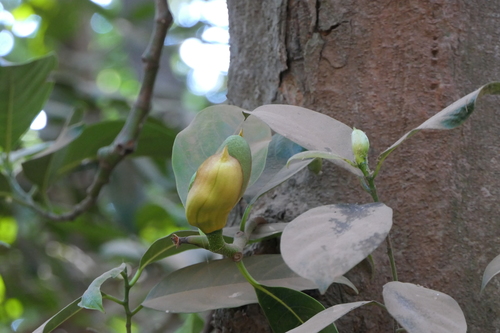Botanical name: Artocarpus heterophyllus | Hindi: कटहल | Marathi: फणस | English: Jackfruit
About
Jackfruit (Artocarpus heterophyllus), also known as कटहल (kathal) in Hindi and फणस (phanas) in Marathi, is an impressive evergreen tree reaching up to 80 feet tall. Its large, glossy leaves can span a foot and exude a sticky latex when broken. The most remarkable feature, however, is its fruit, a massive compound structure that can weigh up to 100 pounds! Covered in spiky protrusions, the unripe fruit is green and hard, while the ripe one turns yellow-green and emits a sweet, fruity aroma. Inside, the flesh is creamy yellow, divided into segments with large, edible seeds.
Interesting Facts

Medicinal Uses: Jackfruit boasts a rich history in traditional medicine. Its leaves, bark, and fruit are used to treat various ailments. The leaves and bark possess anti-inflammatory and antibacterial properties, making them helpful for wound healing and skin conditions. The unripe fruit exhibits antidiabetic potential, while the ripe flesh is rich in antioxidants and vitamins, promoting overall health. Studies are exploring its potential role in managing other health conditions, further solidifying its reputation as a medicinal powerhouse.

Culture & Tradition: Jackfruit plays a significant role in various cultures and traditions. In Southeast Asia, it symbolizes abundance and fertility, often used in celebratory feasts and religious offerings. Its wood is strong and durable, used for furniture, boats, and musical instruments. The sticky latex finds use as glue and a sealant, while the leaves are used as plates or packaging. Jackfruit’s versatility extends to its cultural significance, making it a deeply woven part of various communities’ lives.

Environmental Impact: Jackfruit trees are a boon to the environment. Their large size and dense foliage provide shade and shelter, promoting biodiversity. Their deep roots help prevent soil erosion and maintain soil health. Additionally, they are efficient carbon absorbers, contributing to climate change mitigation. Jackfruit’s ability to thrive in diverse climates and its potential as a sustainable food source make it a valuable asset in the fight against climate change and food insecurity.

Food & Culinary usage: Jackfruit’s culinary potential is vast. The unripe flesh, with its neutral flavor and meaty texture, is a popular meat substitute, especially for vegetarians and vegans. It readily absorbs the flavors of spices and sauces, making it perfect for curries, stews, and stir-fries. The ripe flesh, with its sweet and fruity notes, is enjoyed fresh, used in desserts, or preserved in jams and candies. Jackfruit seeds, roasted or boiled, are a nutritious snack. This culinary versatility makes it a valuable addition to diverse cuisines around the world.

